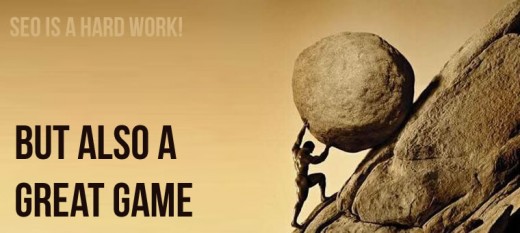Just how old-School SEO ways sunk and modern SEO emerged
The SEO Game

Google dominates the search engines and has never swerved from its core ideology “to organize the world's information and make it universally accessible and useful.” The global SEO space has changed dramatically over time and everybody is working on just two main thing for SEO i.e. pleasing Google to getting ranked up and not get penalized. It must be noted that Google has never considered this a great approach by any means, and has always supported the argument by preaching people to focus on their niche areas and business model, instead of search engine rankings. Through this article we will cover the SEO trends over the years including the changes in traditional ways of work and key pointers on how to approach the newer way of optimization.
The things that were done back THEN
The Tom & Jerry GAME
During the initial years of search engines, getting ranked on top of the SERPs was considered a Game and most of the SEO players relied on inconspicuous means of tricking the search engines. In due time this Game caught the fancy of Google and other notable search engines like Yahoo who had upped the ante and started playing offense. And hence started the Tom-Jerry play offs between SEO experts and the search players.

Team call of Global SEOs - “Let the games begin”
The team SEO took to methods such as reverse engineering, top 10 ranking competition analysis, strategic keyword stuffing, unobtrusive link building maneuvers and other quantity over quality based optimization tactics. There was hardly any orientation towards developing a long serving business model and all creative approach and resources were dedicated to winning the Game and getting traffic.
The Indian SEO vendors had flourished when the worldwide Search Engine Marketing (SEM) companies were busy with manual submission work. We (being part of the same region) took absolute pride in our astute thinking mode, which is why many Indians emerged as top people in this field. Most of them had the exposure overseas regarding search trends, while many had to struggle our way up the ranks in search engine marketing through in-sourcing. The Game helped several companies getting lot of traffic, since the primary motive of all SEO efforts was towards higher ranks on the SERPs and good lead to sales conversion.

Return of the Jedi (Search Engines)
Top search engines like Google and Yahoo started getting more aware of the ongoing activities and played a waiting game. In the meantime they had bolstered their search algorithms and spam filtering processes. The core ideology was never moved from its place, and every addition be it a spam filter or a new indexing feature worked around the one central idea, which was to provide thebest value search results.
When Google was done with developing and testing its new algorithm to tackle the prevalent malicious SEO practices, it rolled out the feature in form of updates. These were named black and white with some relations to a select few employees at Google, popular ones being Panda and Penguin, along with the latest Hummingbird algorithm is more of an infrastructural change that Google had been preparing.

How the GAME changed
Google has always worked with proactive approach, which allowed it to control the entire search world for so long. On the contrary, the SEO professionals reacted and this is the main reason they could never maintain their form in the Game. The illicit activities were thrown out of the picture as the algorithm updates were rolled out by the Google. The rankings went down and traffic was lost overnight leading to mass hysteria amid the global search engine professionals and marketing world.
Speaking of the last couple of years, the entire SEO world has finally realized that fighting in the Game has become meaningless, since the algorithm updates were not going anywhere and all search result optimization efforts would ultimately result in getting tangled within our own created cobwebs.
Sun (Google) stays at center of the SEO solar system
A lot of developments came from the search engine giant’s creative engines, such as the Analytics and Webmaster tools which rendered a Google-made pathway to be followed by everybody. Henceforth, the Game drastically changed with Google emerging on top leaving the search engine marketers with no option but to comply with their guidelines.
The things we do now
If we look at the way things have changed, first the key focus on keywords and back link building strategies was shifted in favor quality content and value addition to the community. This then somehow was transformed into building a strategic business model replete with primary and future goals.
So how did this progression happen? The answer lies in the fact that Internet and Google are evolving just like us and will continue to do so in order to reflect closely on our requirements and behavior. The impact of social media has been eye-opening in this regard, which is still quite new and yet has sent ripples down the digital marketing world. The focus is not only on Google rankings anymore and has shifted in favor of developing a strong brand presence and online reputation after taking all market and social influencing factors into account. This idea always conformed to Google’s core ideology and only now we are noticing what it actually means in the broader picture.
Game evolves into contemporary SEO
The new Game involves creating and mapping your business goals into the present internet marketing needs and reflecting onto the Big Picture. The contemporary SEO practices have one sole directive that is to work in accord with a carefully drawn business, marketing and work layout. Basically it means to employ search optimization strategies in a proactive manner so that they are able to provide natural authority to the entire process flow and follow Google’s stringent guidelines, besides being able to add some amount of organic authenticity to the business. However, good back links are still very much part of an effective SEO campaign and this process needs to be nurtured and developed without any malicious practices, which if present would eventually be caught by Google, and thereby resulting into a penalty.
At present, prevalent digital trends have made it an absolute necessity to integrate search engine optimization as part of the business model, which was actually premeditated by industry top shots years ago. Let’s dive deep into the basic precursors for developing a modern SEO strategy that is in accordance with the key Google guidelines, which I'm working to imbibe in the Search Eccentric internet marketing work culture.
The New-Age SEO Model
Step 1
Develop a clear business plan
The idea is to create a proactive framework to achieve your business goals. This will enable finding the vital processes that can be integrated with robust SEO campaigns and building a solid organic lead-sales conversion structure, which makeup the Big Picture of the entire business model.
Step 2
Determining the future goals and how can your business benefit from internet marketing
This step makes the most sense of all, since it is this area where much of our work will be focused at. Digital marketing practices are developed around key business goals and this is effectively the same thing that Google and other industry gurus have been yelling about.
Step 3
Auditing your site for basic SEO
If your business is suffering because of lost rankings and traffic, then a thorough site audit is your first major step towards earning credibility online and brand rebuilding. A website without any inbound traffic will serve no purpose at all. Hence, it is advisable to conduct a complete on-page and off-page site audit for removing page errors and basic optimization work. This is the most elementary thing and yet it is overlooked by major big players.
Step 4
Evolving with newer ways of conversion
If you want your business to work in the long run, then you have to develop a vision to see the future search engine model and laying out the framework accordingly. I believe this could be done by asking a few questions to oneself.
- Getting acquainted with the key business ideology
- What is your business goal?
- What value do you add to the community?
- What you are good at? What is your niche service area?
- How would you define a perfect success to your business?
Having a clear picture about present and future business goals allows us to develop a clear understanding of present and future workflow. Using this developed vision we could effectively lay down blueprint to manage and integrate key resources from time to time.
-
- Think about how to best serve your users
Your business foundation rests on its ability to provide the necessary services to its targeted customers. If this fundamental feature is absent in your business model then there is no way you could survive the competitive market. Hence, developing a customer centric approach works in the long run. For instance, if you have a blog then it is your responsibility to provide the information people need. We shouldn’t focus on rankings and should rather work on the information quality and Value that helps in building community with people subscribing more because of content and not the rankings. Huffington Post is the best example in this context.
-
- Establishing content
Employing an effective content strategy can put your business on top of its competition. Having high quality content, be it in textual or visual format, helps in brand building, consumer engagement and lead-sales conversion. Moreover when you know your business goal and feel that you can add value by providing some vital info that could help users in anyway and provide you conversion. Time to write them up.
-
- Publicizing the content at correct places
Promoting high quality content is as important as developing it at the moment. Online reputation management requires people at the zenith of their professions conversing and discussing key topics with each other. Google considers this in filtering out spam, and if your content is able to attract top industry analysts and experts then your online reputation is enhanced substantially.
-
- Allowing natural linking of the content and getting traffic from sources (other than Google)
It is high time that individuals and organizations start accepting organic link building strategies rather than looking for a shortcut. Sooner or later you’d be penalized if Google identifies your past endeavors with illicit intentions. Social media channels like Google+ and Twitter are a great way of sharing content nowadays.
-
- Measuring page content and audience behavior
If you are able to understand your audience behavior, then half the problem is already solved. This eventually helps in optimizing conversion rates, since we get some idea as what our target audience finds engaging and is receptive about.
- Creating new business and expanding through loyalty
Staying on top of your game gives you the precious latitude to explore new markets and target audience regions. And if you have a loyal band of customers then business expansion is both smooth and immensely affordable. Further, as a business owner you have to evolve according to the contemporary market trends for newer options and growth areas, which could add value to the current business model.
-
- Take lesson from a HEDGEHOG
The hedgehog concept means “doing one thing and doing it well.” If you are good at your job then it is important to maintain that momentum. The entire brand building process could fail if one project is a disaster. Hence, maintaining a reputation is more important in this business than any ranking or traffic factor.
-
- Follow the above steps over again and keep adding new and more exciting inputs.
Step 5
On-site audit to evaluate if your business goals are measurable
If your website is able to convert prospective leads into customers then it is important to have a framework to monitor this behavior. This will allow enhancing the lead-sales conversion ratio by developing better user interface and experience for the target audience. Since our SEO strategy was built around business goals, we need an evaluation plan to see if it’s working out as planned or not. Doing this we will know beforehand if something needs to be changed. This is something that optimization is all about.
Step 6
Building your brand the GOOGLE way
Following Google guidelines is the prescribed way of conducting the new-age SEO practices. Brand advocacy via well-established players is one way, besides healthy relationship building with customers, engaging in social efforts and actively participating in key industry events are great channels for developing an authentic brand building strategy.
Step 7
Conscientiously understanding target audience behavior
This step involves diving deep into the audience behavior through Google Analytics and Webmaster tools. Using the detailed visitor personas and descriptions we can effectively develop digital campaigns and provide services tailored for our target audience.
-
This would mean studying the age group of users and people.
-
What device they are using?
-
What are their objects – does their query their matching our site content?
Step 8
Competition analysis
A good offense is the best defense. In order to beat the competition, we have to highlight our niche service and believe in our service potential. We can start by pitching in solutions that our competitors can only think of, thereby creating a solid brand image and community reputation.
Step 9
Make sure that all the departments work together and believe in a strategy that correlates
It is important that all teams work together towards achieving the target business goals. The modern way of work depends on this teamwork, since no department can run successfully and survive exclusively working on its own. A good example can be of how to get your CEO to pay for Internet marketing or creating a content marketing budget.
Conclusion
The reason we can’t deep dive into the above and explicitly talk about the modern key SEO practices is that every website’s purpose is different from each other. The research, understanding and decision making processes are solely the work criterion of an Internet Marketing agency and are more complex and profound in nature. Although I have covered most of the important points, their real significance lie deep in their meaning and employment. An expert or someone who can talk to the business effectively can do a great job. The others might not be.
Where you are is a great place to start. I believe this is like where we all are whenever we are but that would need changing. Take the steps and enjoy the ride. The good thing here is that your efforts won’t stop because search engines changes won’t let you, and when you reach your goal there will be new ones to make and work on. The points I have compiled can’t be addressed and implemented at one go but working towards them would get you to nail them effectively.








